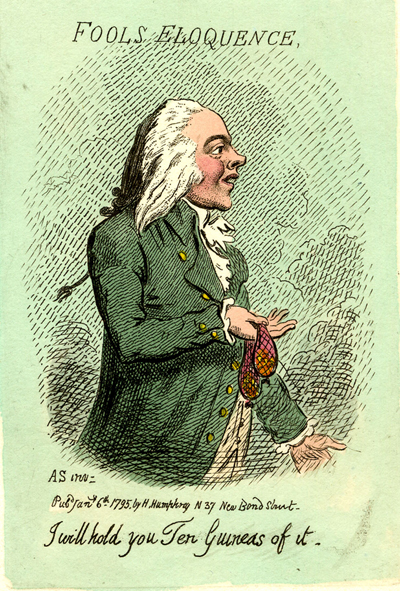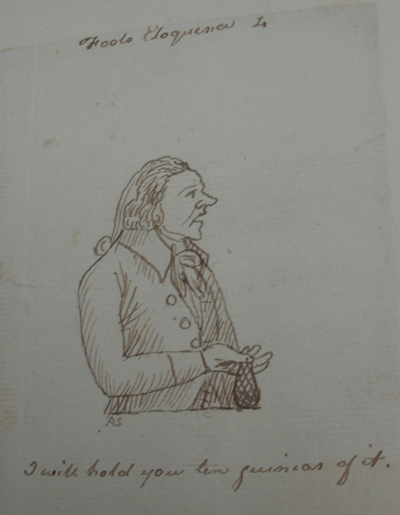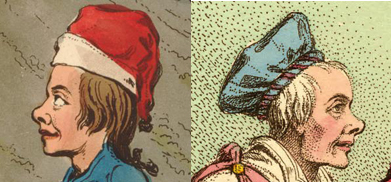Fools Eloquence
Fools Eloquence is one of a series of caricatured portraits (all listed as being published on January 6th, 1795) illustrating eight kinds of eloquence, and sometimes associated with particular, real-life individuals. For more about the series as a whole, see my Overview.

© Trustees of the British Museum
The print is based on a drawing most likely by Samuel Collings, AKA Annibal Scratch in the British Museum.

Fools Eloquence
Drawing [December 1794?]
© Trustees of the British Museum
© Photo by Jim Sherry
Neither Wright & Evans nor Joseph Grego have anything to say about the identity of the "Fool" represented; in fact, they don't include any of the Eloquence series in their commentaries. Without venturing a definitive identification, Dorothy George and the British Museum, on the other hand, suggest that "He resembles caricatures of Lord Lauderdale."
James Maitland, 8th Earl of Lauderdale, was an ardent defender of the French Revolution and in 1794/1795 a staunch opponent of continuing the war against France. He first appeared in The eruption of the mountain, - or - the horrors of the 'Bocca del Inferno in July of 1794 leading a procession of sans-culotte Whigs. He later appears as one of Les Membres du Conseil des Cinq Cents in Gillray's French Habits in 1798. There is an overall consistency between Gillray's Lauderdale in 1794 and 1798, both likely deriving from Sayer's image of Lauderdale as the Frenchman Brissot in Illustrious Heads designed for a new History of Republicanism, in French and English, dedicated to the Opposition.1794. But neither caricature portrait looks at all like the figure in Collings' drawing, and there is only slightly more resemblance to the figure in Gillray's version of Fools Eloquence.

© Trustees of the British Museum and Lewis Walppole Library, Yale University
The caption or example of a "fool's eloquence" ("I will hold you Ten Guineas of it.") appears to be a bet being made as in this scene from Thomas Otway's The Atheist, or the Soldier's Fortune.
Then do you hear, friend, you Atheist, that are so free of your soul, let us see if you dare venture a little money of your own now—Come [Draws out a box and dice.] Seven's the main: I'll hold you ten pounds to two, two duces does not come before seven. (Act III, Scene 1)
The combination of title and and caption would then seem to suggest the foolishness of hastily placing bets, illustrating the old proverb, "A fool and his money are soon parted."
But so far as I can tell, Lauderdale was not a gambling man, and during his speeches in the House of Lords in 1794, there are no reference to bets of any kind. So if Collings and Gillray meant to portray Lauderdale, why didn't Gillray repeat the formula he had already used in 1794? And why did Collings choose an example of eloquence that seems to have no obvious connection to Lauderdale?
Sources and Reading
- Commentary from the British Museum on Fools Eloquence.
- "Samuel Collings," Wikipedia
- "James Maitland, 8th Earl of Lauderdale," Wikipedia
- "title," Wikipedia
Comments & Corrections
NOTE: Comments and/or corrections are always appreciated. To make that easier, I have included a form below that you can use. I promise never to share any of the info provided without your express permission.